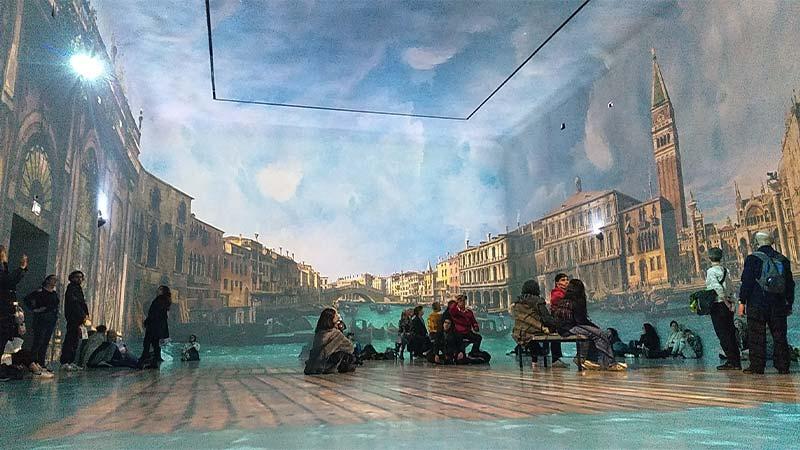Westminster postgraduate students have had the opportunity to visit Frameless, a multi-sensory experience art exhibition in central London, to explore the world of immersive art.

On 27 September, students from the MA Multimedia Journalism, Digital Media: Storytelling and Production and Film, Television and Moving Image courses visited Frameless to explore the world of immersive art as part of Welcome Week 2024 at the School of Media and Communications.
Frameless is the largest permanent multi-sensory experience in the UK and showcases some of the world’s greatest works of art in ways never seen before. Using five surface wrapround projection technology and a mix of both classical music and specially commissioned score music, the four galleries of The Art of Abstraction, The World Around Us, Colour in Motion and Beyond Reality bring the works of artists Klimt, Canaletto, Monet, Turner and van Gogh to life.
Upon experiencing the exhibition, students learned ways in which new technology can be harnessed to foster interest and curiosity in the world and the ways in which artists have captured its complexity over time. They started their learning journey at the University of Westminster by seeing how creativity can challenge and change their own perceptions.
One student said: “It makes me want to go to the National Gallery and see old pictures again. Perhaps, they aren't as outdated as I thought.”
The animation of Hokusai’s Great Wave off Kanagawa from the series of landscape prints titled 36 Views of Mount Fuji, was displayed across the room crashing down to the gallery floor, which was a memorable highlight to the visit. This series depicts Mount Fuji from different locations and in various seasons and weather conditions, and the Great Wave print is the best-known print in the collection. In one corner of the room, a small ripple started, which built and moved around the room, so by the time it became the Great Wave, it had grown in its journey across three sides of the gallery. The sound started from being a gentle seaside to crashing waves, which gave a huge sense of the size and enormity of the wave and brought the image to life, affecting the senses by creating a real emotional response.
Course leaders whose students attended the trip were Natasha Fernando from the Digital Media: Storytelling and Production course, Reshel Shah from Business of Film MA, Eleanor Roseblade from Film, Television and Moving Image MA. They said: “It was a great experience for our students to introduce them to innovative ways of seeing. New technology has been crafted to allow the modern audience to experience culture from across the globe in a new and engaging way.”
This trip directly contributed to the United Nations Sustainable Development Goals (SDG) 4: Quality Education. Since 2019, the University of Westminster has used the SDGs holistically to frame strategic decisions to help students and colleagues fulfil their potential and contribute to a more sustainable, equitable and healthier society.
Find out more about the Media and Communications courses at Westminster.


